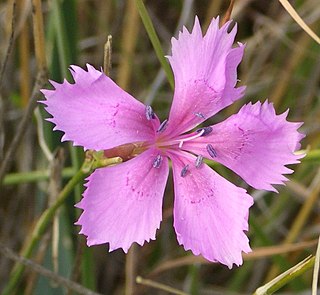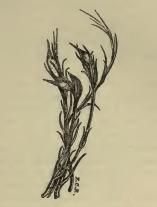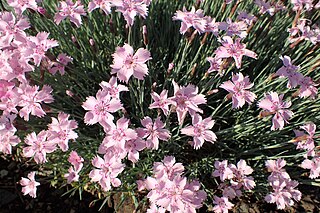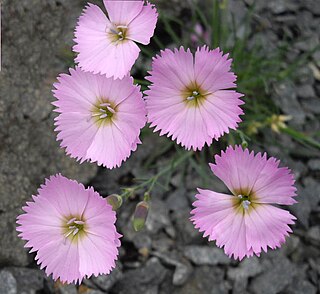
Dianthus caryophyllus, commonly known as the carnation or clove pink, is a species of Dianthus. It is likely native to the Mediterranean region but its exact range is unknown due to extensive cultivation for the last 2,000 years.

Caryophyllaceae, commonly called the pink family or carnation family, is a family of flowering plants. It is included in the dicotyledon order Caryophyllales in the APG III system, alongside 33 other families, including Amaranthaceae, Cactaceae, and Polygonaceae. It is a large family, with 81 genera and about 2,625 known species.

Dianthus is a genus of about 340 species of flowering plants in the family Caryophyllaceae, native mainly to Europe and Asia, with a few species in north Africa and in southern Africa, and one species in arctic North America. Common names include carnation, pink and sweet william.

A wildflower is a flower that grows in the wild, meaning it was not intentionally seeded or planted. The term implies that the plant probably is neither a hybrid nor a selected cultivar that is in any way different from the way it appears in the wild as a native plant, even if it is growing where it would not naturally. The term can refer to the flowering plant as a whole, even when not in bloom, and not just the flower.

Dianthus chinensis, commonly known as rainbow pink or China pink is a species of Dianthus native to northern China, Korea, Mongolia, and southeastern Russia. It is a herbaceous perennial plant growing to 30–50 cm tall.

Dianthus barbatus, the sweet William, is a species of flowering plant in the family Caryophyllaceae, native to southern Europe and parts of Asia. It has become a popular ornamental garden plant. It is a herbaceous biennial or short-lived perennial plant growing to 13–92 cm tall, with flowers in a dense cluster of up to 30 at the top of the stems. Each flower is 2–3 cm diameter with five petals displaying serrated edges. Wild plants produce red flowers with a white base, but colours in cultivars range from white, pink, red, and purple to variegated patterns. The exact origin of its English common name is unknown but first appears in 1596 in botanist John Gerard's garden catalogue. The flowers are edible and may have medicinal properties. Sweet William attracts bees, birds, and butterflies.

Dianthus deltoides, the maiden pink, is a species of Dianthus native to most of Europe and western Asia. It can also be found in many parts of North America, where it is an introduced species.

Dianthus armeria, the Deptford pink or grass pink, is a species of Dianthus ("pink") native to most of Europe, from Portugal north to southern Scotland and southern Finland, and east to Ukraine and the Caucasus. It is naturalised in North America.

Dianthus gratianopolitanus, commonly known as the Cheddar pink or clove pink, is a species of plant in the family Caryophyllaceae. It is a herbaceous perennial, hardy to zones 4–8. It grows to a height of 0.5 to 1 feet, blooming from May to June. Flowers are fragrant and rose pink. Grows best in full sun, and has medium water requirements. Overwatering or poor drainage leads to crown rot, and plants do not tolerate wet winter soil conditions.

Dianthus superbus, the fringed pink or large pink, is a species of Dianthus native to Europe and northern Asia, from northernmost Spain and France north to arctic Norway, and east to Japan; in the south of its range, it occurs at high altitudes, up to 2,400 m.

The pink lanternshark is a shark of the family Etmopteridae found around Australia and New Caledonia, at depths of between 110 and 880 m. Its length is up to 41 cm.

HMS Dianthus was a Flower-class corvette of the Royal Navy. She was launched on 9 July 1940 from the Leith Docks on the Firth of Forth and named after the genus of flowering plants including Carnation, Pink, and Sweet William. The ship escorted trade convoys between Newfoundland and the Western Approaches through the Battle of the Atlantic wolf pack attacks of the winter of 1942–43.
German submarine U-379 was a Type VIIC U-boat built for Nazi Germany's Kriegsmarine for service during World War II. She was laid down on 27 May 1940 by Howaldtswerke, Kiel as yard number 10, launched on 15 October 1941 and commissioned on 29 November 1941 under Kapitänleutnant Paul-Hugo Kettner.

Caryocolum leucomelanella is a moth of the family Gelechiidae. It is found in most of Europe, except Ireland, Great Britain, the Benelux, Portugal, Fennoscandia and the Baltic region. It is also found in Russia.

Caryocolum schleichi is a moth of the family Gelechiidae. It is found in central, most of western and parts of eastern Europe, Morocco, Turkey, Syria, Afghanistan and Mongolia.

Dianthus libanotis, the Mount Libanus pink or Lebanon pink, is a herbaceous perennial plant of the family Caryophyllaceae.

Dianthus plumarius, also known as the common pink, garden pink, or wild pink, or simply pink, is a species of flowering plant in the family Caryophyllaceae.

Metridium dianthus is a species of sea anemone in the family Metridiidae. It is found in the northern Atlantic Ocean and in the northeast Pacific Ocean. There is also a record from South Africa, possible resulting from an introduction.

Dianthus sylvestris, the wood pink, is a species of Dianthus found in Europe, particularly in the Alps, and also said to be disjunctly found in the mountains of Greece. A perennial, it prefers to grow in drier, stony places, so it is occasionally planted in rock gardens.


















